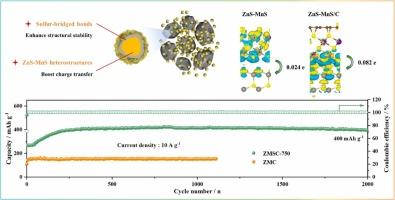具有异质结构和硫桥的双金属硫化物/碳复合阳极在高性价比全锰基钠离子电池中的界面工程
IF 17.1
1区 材料科学
Q1 CHEMISTRY, PHYSICAL
引用次数: 0
摘要
设计同时实现高容量、结构稳定性和快速动力学的阳极材料仍然是钠离子(Na-ion)电池的关键挑战。在此,我们提出了一种有针对性的界面工程策略,构建了具有双金属硫化物异质结构和界面硫桥键的碳修饰ZnS-MnS/C (ZMSC)复合阳极,用于所有锰基钠离子电池(amsib)。带隙和电负性的内在差异在它们的界面处诱导了一个内置的电场,促进了电荷的重新分配和异质结构的形成。碳修饰建立了硫桥键,将活性金属纳米颗粒紧密地锚定在碳基体上,增强了界面耦合,有效地抑制了结构降解。这种协同设计在10.0 a g−1下,在2000次循环中实现了400 mAh g−1的显著可逆容量。当与NaMn2O4阴极配对时,所获得的AMSIBs表现出优异的性能和稳定性,强调了其开发经济高效的Na储能系统的实际可行性。本文章由计算机程序翻译,如有差异,请以英文原文为准。

Interface engineering of bimetallic sulfide/carbon composite anode with heterostructures and sulfur bridges for cost-effective all manganese-based sodium-ion batteries
Designing anode materials that simultaneously achieve high capacity, structural stability, and fast kinetics remains a critical challenge for sodium-ion (Na-ion) batteries. Herein, we propose a targeted interface engineering strategy construct a carbon decorated ZnS-MnS/C (ZMSC) composite anode featuring bimetallic sulfide heterostructures and interfacial sulfur-bridged bonds for all Mn-based Na-ion batteries (AMSIBs). The intrinsic differences in bandgap and electronegativity induce a built-in electric field at their interface, promoting charge redistribution and heterostructure formation. Carbon decoration establishes sulfur-bridged bonds that tightly anchor active metal nanoparticle to the carbon matrix, enhancing interfacial coupling and effectively suppressing structural degradation. Such synergistic design achieves a remarkable reversible capacity of 400 mAh g−1 over 2000 cycles at 10.0 A g−1. When paired with NaMn2O4 cathode, the obtained AMSIBs demonstrated excellent performance and stability, underscoring its practical viability for the development of cost-effective and high-performance Na energy storage systems.
求助全文
通过发布文献求助,成功后即可免费获取论文全文。
去求助
来源期刊

Nano Energy
CHEMISTRY, PHYSICAL-NANOSCIENCE & NANOTECHNOLOGY
CiteScore
30.30
自引率
7.40%
发文量
1207
审稿时长
23 days
期刊介绍:
Nano Energy is a multidisciplinary, rapid-publication forum of original peer-reviewed contributions on the science and engineering of nanomaterials and nanodevices used in all forms of energy harvesting, conversion, storage, utilization and policy. Through its mixture of articles, reviews, communications, research news, and information on key developments, Nano Energy provides a comprehensive coverage of this exciting and dynamic field which joins nanoscience and nanotechnology with energy science. The journal is relevant to all those who are interested in nanomaterials solutions to the energy problem.
Nano Energy publishes original experimental and theoretical research on all aspects of energy-related research which utilizes nanomaterials and nanotechnology. Manuscripts of four types are considered: review articles which inform readers of the latest research and advances in energy science; rapid communications which feature exciting research breakthroughs in the field; full-length articles which report comprehensive research developments; and news and opinions which comment on topical issues or express views on the developments in related fields.
 求助内容:
求助内容: 应助结果提醒方式:
应助结果提醒方式:


